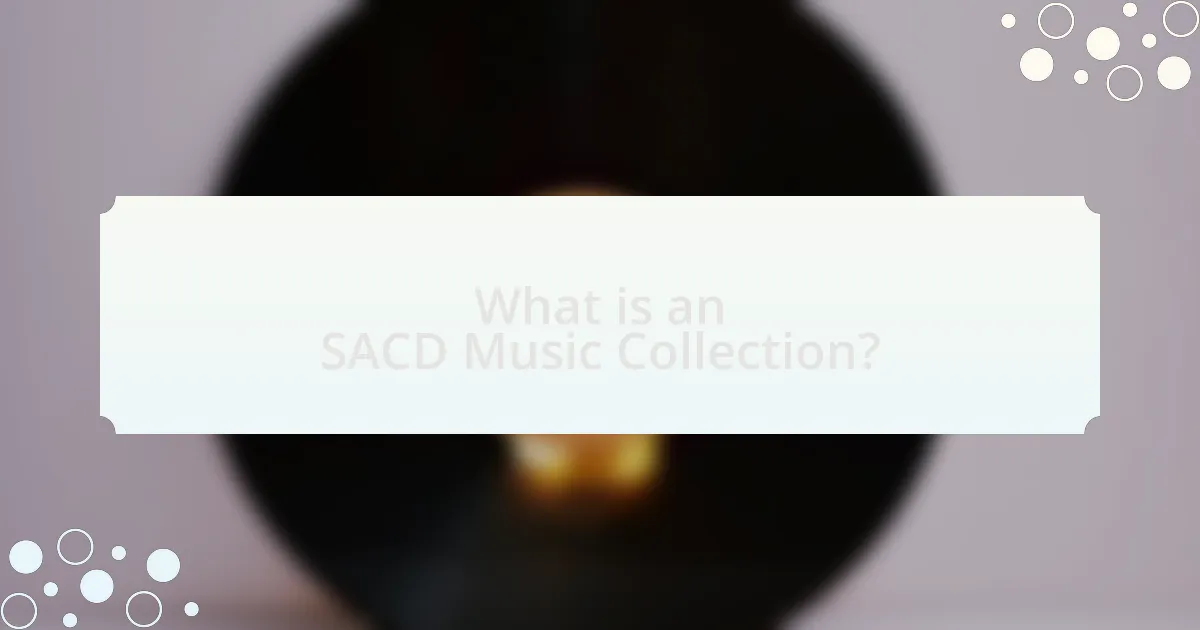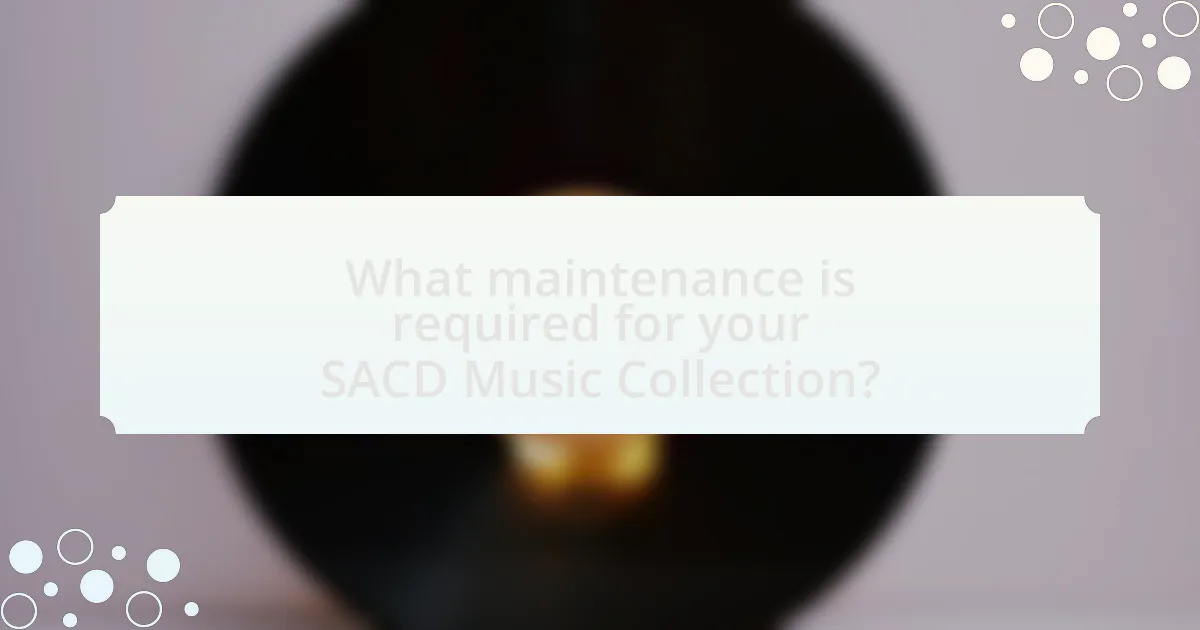The main entity of the article is the SACD Music Collection, which consists of Super Audio CDs designed for high-resolution audio playback. The article provides a comprehensive overview of SACDs, detailing their technical specifications, differences from standard CDs, and the benefits of owning an SACD collection. It also covers best practices for storing, cleaning, and organizing SACDs to ensure their longevity and optimal playback quality. Additionally, the article discusses common issues with SACDs and offers troubleshooting tips, as well as techniques for enhancing the listening experience.
What is an SACD Music Collection?

An SACD Music Collection consists of Super Audio CDs, which are high-resolution audio discs designed to provide superior sound quality compared to standard CDs. SACDs utilize a different encoding format called Direct Stream Digital (DSD), allowing for a wider frequency range and greater dynamic range. This format supports multi-channel audio, enabling listeners to experience surround sound. The SACD format was developed by Sony and Philips and was introduced in 1999, aiming to enhance the listening experience for audiophiles.
How does an SACD differ from other music formats?
An SACD, or Super Audio CD, differs from other music formats primarily in its ability to deliver high-resolution audio. Unlike standard CDs that typically offer 16-bit/44.1 kHz audio, SACDs can provide 1-bit/2.8224 MHz DSD (Direct Stream Digital) audio, resulting in a more detailed and dynamic sound experience. This high-resolution capability allows SACDs to reproduce audio frequencies beyond the range of standard CDs, enhancing the listening experience for audiophiles. Additionally, SACDs often include a standard CD layer, making them compatible with regular CD players, while still offering the superior sound quality when played on SACD-compatible devices.
What are the technical specifications of SACD?
The technical specifications of Super Audio CD (SACD) include a storage capacity of up to 4.7 GB for single-layer discs and 8.5 GB for dual-layer discs. SACD utilizes Direct Stream Digital (DSD) encoding, which operates at a sampling rate of 2.8224 MHz, significantly higher than the standard CD’s 44.1 kHz. This format supports multi-channel audio, allowing for up to six channels (5.1 surround sound). Additionally, SACDs can contain a standard CD layer, making them compatible with regular CD players. These specifications contribute to SACD’s ability to deliver high-resolution audio quality, which is a key feature of the format.
Why is SACD considered a high-resolution audio format?
SACD is considered a high-resolution audio format because it utilizes Direct Stream Digital (DSD) encoding, which offers a sampling rate of 2.8224 MHz, significantly higher than the standard CD’s 44.1 kHz. This higher sampling rate allows for greater detail and accuracy in sound reproduction, resulting in a more immersive listening experience. Additionally, SACD supports multi-channel audio, enhancing the spatial quality of music. The combination of these technical specifications confirms SACD’s status as a high-resolution audio format.
What are the benefits of owning an SACD collection?
Owning an SACD collection provides superior audio quality, as SACDs utilize a higher sampling rate and bit depth compared to standard CDs, resulting in more detailed sound reproduction. This enhanced audio fidelity is due to the Direct Stream Digital (DSD) encoding used in SACDs, which captures sound more accurately, making it particularly appealing for audiophiles. Additionally, SACDs often include multi-channel audio options, allowing for an immersive listening experience that standard formats do not offer. The combination of these factors makes SACDs a valuable addition for those seeking high-quality music playback.
How does SACD enhance the listening experience?
SACD enhances the listening experience by providing superior audio quality through its high-resolution sound capabilities. Unlike standard CDs, SACDs utilize a DSD (Direct Stream Digital) format that captures audio at a much higher sampling rate, resulting in greater detail and clarity. This format allows for a more immersive listening experience, as it reproduces sound with a wider dynamic range and improved frequency response, making music feel more lifelike. Studies have shown that listeners often perceive SACD recordings as more engaging and enjoyable compared to traditional formats, reinforcing the value of SACD in enhancing audio enjoyment.
What genres of music are best represented in SACD format?
SACD format is best represented by genres such as classical, jazz, and rock. These genres benefit from the high-resolution audio capabilities of SACD, which allows for a more dynamic range and clarity in sound. Classical music often utilizes the multi-channel capabilities of SACD to create an immersive listening experience, while jazz recordings take advantage of the format’s ability to capture intricate details in instrumentation. Rock music, particularly from iconic bands, has also been remastered in SACD to enhance audio fidelity, making it a popular choice among audiophiles.
How should you store your SACD Music Collection?

To store your SACD music collection, keep the discs in their original cases to protect them from scratches and dust. Storing SACDs vertically, similar to vinyl records, prevents warping and allows for better air circulation. Additionally, maintain a stable environment with low humidity and moderate temperature to avoid damage from moisture and heat, as SACDs are sensitive to extreme conditions. Proper storage methods help preserve the audio quality and longevity of the discs, ensuring optimal playback performance.
What are the best practices for SACD storage?
The best practices for SACD storage include keeping the discs in a cool, dry environment, away from direct sunlight and extreme temperatures. Proper storage involves using protective cases to prevent scratches and dust accumulation, as well as storing the discs vertically to avoid warping. Additionally, handling the discs by the edges minimizes the risk of fingerprints and smudges, which can affect playback quality. These practices help maintain the integrity of the SACD format, which is sensitive to environmental conditions and physical damage.
How does temperature and humidity affect SACD longevity?
Temperature and humidity significantly impact the longevity of SACDs (Super Audio CDs). High temperatures can cause the adhesive used in the disc’s layers to degrade, leading to delamination, while excessive humidity can promote mold growth and corrosion on the disc surface. Research indicates that optimal storage conditions for SACDs are around 20°C (68°F) with a relative humidity of 40-50%. Deviating from these conditions can shorten the lifespan of the discs, as evidenced by studies showing that discs stored in environments exceeding 30°C (86°F) or with humidity levels above 60% experience accelerated deterioration.
What types of storage cases are recommended for SACDs?
Recommended storage cases for SACDs include hard-shell cases, jewel cases, and slimline cases. Hard-shell cases provide robust protection against physical damage and environmental factors, while jewel cases offer a classic design with a secure fit for the discs. Slimline cases are space-efficient, allowing for compact storage without sacrificing protection. These types of cases help maintain the integrity of SACDs, which are sensitive to scratches and environmental conditions. Proper storage in these cases can extend the lifespan of the discs and preserve audio quality.
How can you organize your SACD collection effectively?
To organize your SACD collection effectively, categorize the discs by genre, artist, or label. This method allows for easier access and retrieval, enhancing the overall experience of enjoying your collection. For instance, grouping by genre enables quick identification of specific music styles, while organizing by artist provides a streamlined way to find all works by a particular musician. Additionally, using protective cases and maintaining a catalog, either digitally or on paper, can help track your collection and prevent damage. This approach is supported by best practices in music collection management, which emphasize organization for optimal enjoyment and preservation.
What are the most common methods for cataloging SACDs?
The most common methods for cataloging SACDs include using digital databases, physical inventory lists, and specialized software. Digital databases allow collectors to input detailed information about each SACD, such as artist, album title, and release date, making it easy to search and sort. Physical inventory lists can be maintained in spreadsheets or notebooks, providing a tangible record of the collection. Specialized software designed for music collections often includes features for tracking condition, value, and location of each SACD, enhancing organization and management. These methods are widely adopted by collectors to ensure efficient tracking and maintenance of their SACD collections.
How can digital tools assist in organizing your collection?
Digital tools can assist in organizing your collection by providing efficient cataloging, tracking, and management features. These tools, such as database software and mobile applications, allow users to input detailed information about each item, including title, artist, genre, and condition, which facilitates easy retrieval and sorting. For instance, software like Discogs or MusicBrainz enables users to maintain an up-to-date inventory and offers features like barcode scanning for quick entry. Additionally, digital tools often include search functions and tagging systems that enhance accessibility and organization, making it easier to locate specific items within a large collection.
What maintenance is required for your SACD Music Collection?

To maintain your SACD music collection, store the discs vertically in a cool, dry environment to prevent warping and scratching. Regularly clean the discs with a microfiber cloth to remove dust and fingerprints, ensuring that you wipe from the center outward to avoid scratches. Additionally, keep the cases in good condition to protect the discs from physical damage. Proper handling, such as avoiding touching the playing surface, further preserves the quality of the SACDs. These practices are essential for maintaining the integrity and longevity of your collection.
How should you clean your SACDs to ensure longevity?
To clean your SACDs and ensure their longevity, use a microfiber cloth to gently wipe the disc from the center outward. This method minimizes the risk of scratches and preserves the integrity of the disc’s surface. Additionally, avoid using any abrasive materials or cleaning solutions that contain alcohol, as these can damage the disc. Research indicates that maintaining a clean surface helps prevent playback issues and extends the lifespan of optical discs, including SACDs.
What cleaning materials are safe for SACD surfaces?
Cleaning materials that are safe for SACD surfaces include microfiber cloths, distilled water, and isopropyl alcohol at a concentration of 70% or lower. Microfiber cloths effectively remove dust and fingerprints without scratching the surface, while distilled water is gentle and does not leave mineral deposits. Isopropyl alcohol can be used for more stubborn stains, but it should be diluted to ensure it does not damage the SACD coating. These materials are recommended by manufacturers and experts in the field to maintain the integrity of SACD discs.
How often should you clean your SACDs?
You should clean your SACDs every time you notice visible dust or fingerprints on the surface. Regular cleaning helps maintain optimal playback quality and prevents potential damage to the disc. It is advisable to use a soft, lint-free cloth and a suitable cleaning solution specifically designed for optical discs to avoid scratching. Regular maintenance ensures longevity and preserves the audio quality of your SACD collection.
What precautions should you take to protect your SACD collection?
To protect your SACD collection, store the discs in a cool, dry environment away from direct sunlight and humidity. High temperatures and moisture can warp the discs and degrade the quality of the audio. Additionally, use protective cases to prevent scratches and dust accumulation, as these can affect playback quality. Regularly check the condition of the discs and clean them with a soft, lint-free cloth to remove fingerprints or smudges, ensuring that you wipe from the center outward to avoid scratches. These precautions are essential for maintaining the integrity and longevity of your SACD collection.
How can you prevent scratches and damage to your SACDs?
To prevent scratches and damage to your SACDs, always handle them by the edges and avoid touching the shiny surface. This practice minimizes the risk of fingerprints and scratches that can affect playback quality. Additionally, store SACDs in their original cases or protective sleeves to shield them from dust and physical impact. Keeping your SACDs in a controlled environment, away from direct sunlight and extreme temperatures, further protects them from warping and degradation. Regularly cleaning the discs with a soft, lint-free cloth in a straight motion from the center outward can also help maintain their condition.
What environmental factors should you monitor to protect your collection?
To protect your SACD music collection, you should monitor temperature, humidity, light exposure, and air quality. Maintaining a stable temperature between 60-70°F prevents warping and degradation of the discs. Humidity levels should be kept between 30-50% to avoid mold growth and physical damage. Limiting light exposure, especially UV light, reduces the risk of fading and deterioration of packaging and labels. Finally, ensuring good air quality by minimizing dust and pollutants helps preserve the integrity of the collection.
What are common issues with SACDs and how can you troubleshoot them?
Common issues with SACDs include playback problems, compatibility issues with players, and physical damage to the discs. To troubleshoot playback problems, ensure that the SACD player is set to the correct mode for SACD playback, as some players may default to CD mode. For compatibility issues, check if the player supports SACD formats, as not all CD players do. If the disc is physically damaged, inspect it for scratches or dirt; cleaning the disc with a soft, lint-free cloth can often resolve playback issues. Additionally, ensure that the firmware of the SACD player is up to date, as updates can improve compatibility and performance.
How can you identify playback issues with SACDs?
To identify playback issues with SACDs, listen for distortions, skipping, or a lack of sound during playback. These symptoms often indicate problems with the SACD itself, the player, or the connection. Additionally, check for visible scratches or dirt on the disc, as these can affect playback quality. If the SACD plays correctly on another player, the issue may lie with the original player. Regularly updating the firmware of the SACD player can also help mitigate playback issues, as manufacturers often release updates to improve compatibility and performance.
What steps can you take to resolve common SACD problems?
To resolve common SACD problems, first ensure that the SACD player is compatible with the disc format, as some players may not support hybrid SACDs. If playback issues occur, clean the disc with a soft, lint-free cloth, wiping from the center outward to avoid scratches. Additionally, check the connections and cables to ensure they are secure and functioning properly. If the SACD still does not play, try resetting the player to its factory settings, as this can resolve software glitches. Lastly, consult the user manual for specific troubleshooting steps related to the model of the SACD player, as manufacturers often provide tailored solutions for common issues.
What are the best practices for enjoying your SACD Music Collection?
To enjoy your SACD music collection, use a high-quality SACD player that supports both SACD and CD formats for optimal sound quality. This ensures that you experience the full dynamic range and audio fidelity that SACDs offer, which is significantly better than standard CDs due to their higher resolution. Additionally, store your SACDs in a cool, dry environment away from direct sunlight to prevent damage to the discs. Regularly clean your SACDs with a soft, lint-free cloth to avoid scratches and maintain sound quality. Following these practices will enhance your listening experience and preserve the integrity of your collection.
How can you set up your audio system for optimal SACD playback?
To set up your audio system for optimal SACD playback, ensure you use a dedicated SACD player that supports both stereo and multi-channel formats. A high-quality SACD player is essential because it decodes the DSD (Direct Stream Digital) format used by SACDs, providing superior sound quality compared to standard CD players. Additionally, connect the player to a compatible AV receiver or amplifier that can handle high-resolution audio formats, ensuring it has HDMI or analog outputs for the best signal transfer.
Using high-quality interconnects and speaker cables will further enhance audio fidelity. Position your speakers correctly, ideally in a triangle formation with the listening position, to achieve the best soundstage and imaging. Finally, consider room acoustics; adding sound-absorbing materials can minimize reflections and improve overall sound quality. These steps collectively ensure that your audio system is optimized for the unique characteristics of SACD playback.
What listening techniques enhance the SACD experience?
Listening techniques that enhance the SACD experience include using high-quality audio equipment, optimizing speaker placement, and employing a dedicated listening environment. High-quality audio equipment, such as SACD players and amplifiers, ensures that the superior sound quality of SACDs is fully realized. Proper speaker placement, ideally in a symmetrical arrangement and at ear level, allows for optimal soundstage and imaging, enhancing the listening experience. Additionally, a dedicated listening environment, free from noise and distractions, allows listeners to fully immerse themselves in the high-resolution audio that SACDs provide. These techniques collectively contribute to a more engaging and enjoyable SACD listening experience.

Leave a Reply